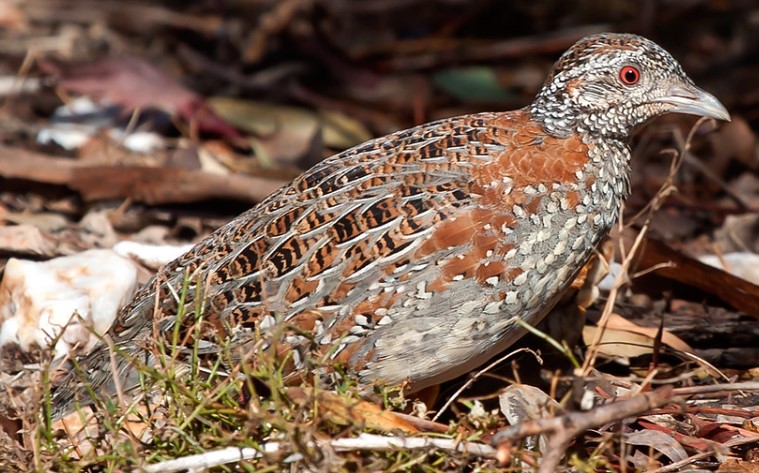Family: Painted buttonquail (Turnix varius) is the quails that belong to the family Turnicidae, but do not closely resemble quails in the Phasianidae family.
Behaviour & Habitats: Painted Button-quail, contrary to most other quail-like birds, inhabit open scrublands and low woodlands and forests, especially where patches of patchy tussocks of grass are mixed with a layer of twigs and leaves litter on stony ridges, slopes, and hillsides.
An open grass field or an area that has been cleared or grazed is considered to be unsuitable. In this habitat, Painted Button-quail are still moderately abundant in their range, although they are no longer as numerous as they were over a century ago. In contrast to some birds, which are sedentary, there are others that are nomadic, especially young birds that disperse southward from their parental territories in order to breed in spring in the extreme southeast. It seems that Painted button-quails are as insectivorous as granivorous and that they have a thinner bill than the other large button-quails.
During the day, they dig up most of their food from the leaf mulch, scratching alternately with each foot and clearing distinctive circular scrapes on their bodies. There are often pairs of them and sometimes there are small coveys of them. When disturbed, they run away and hide, only flushing when hard pressed, and then bursting up and flying off low with rapidly whirring wings for at least 50 meters or more when they are forced to fly. In the world of birds, females are the larger and more colorful sex; they defend their territories, dominate their courtships, and mate with several males each season, leaving them to incubate and rear their young.

Other Names: This is also known as Painted Quail, Butterfly Quail, Scrub Quail, and Varied Quail.
Size: Approximately 170 mm in length for males and 200 mm for females.
Identification: MALE: A broad pair of rufous stripes mottled with black forms the crown. The rest of the upper parts are mid-grey-brown washed rufous on the mantle and sides of the neck, coarsely mottled with black and feather-edged white at the rump. The wings and shoulders are mid-grey, while the wing covers are mottled with white and black. The face and throat are freckled white. Olive-grey breasts and flanks with coarse cream spots, grading to plain cream on the belly and undertail. The eyes are red. The bill is horn-grey in color. Feet are dull yellow; while claws are horn. FEMALE: Similar to male, but more dully and smoothly marked, with rufous markings on the crown, mantle, and sides of the neck, and finer spots on the breast. IMMATURES: White and black spots are more clearly defined on upper parts, no rufous wash; breast spots are larger. DOWNY YOUNG: Gray-brown above with cream stripes at the central and lateral corners, creamier below.
Call: The female produces a low booming call resembling that of a courting Emu or Bronze Wing Pigeon. Standing on tip-toe and inflating the chest, usually at night. Male bird is usually silent.
Nest and Breeds: Nesting and breeding seasons last from August to March, as well as other months in the northern part of the range. An earth nest, lined with grass and leaves, sometimes partially dome-shaped, is built on the ground at the base of a shrub or tuft of grass.
Eggs: There are usually four eggs laid by the quail, which are glossy white, minutely speckled with light brown, and have large black and sepia stripes; round to pyriform, about 27 x 20 mm in size. Males incubate for about 14-15 days.
Distribution: Throughout southern Australia, north of the Atherton Tablelands, the Painted Button-Quail can be found in lightly forested countries. The species is found in Queensland, New South Wales, Victoria, South Australia, and Tasmania. West Australians in the southwestern part of the state have their own population.
Races: In 1801 the English ornithologist John Latham described the painted buttonquail under the binomial name Perdix varia. It exists in two races: one on the mainland and one on the Houtman Abralhos, WA. Read More – Red-backed Button-quail (Turnix maculosa)
